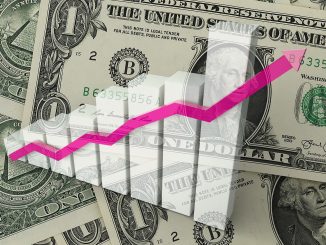 Stopped in at my local Starbuck’s yesterday (after a brutal soccer game that left me half paralyzed) and picked up a copy of the NY Times. In it, I came across this article by Tyler Cowen: Can the Fed Offer a Reason to Cheer? The article constitutes a nice summary of what many people think is wrong with the economy and what should be done about (at least, as far as monetary policy is concerned).
Stopped in at my local Starbuck’s yesterday (after a brutal soccer game that left me half paralyzed) and picked up a copy of the NY Times. In it, I came across this article by Tyler Cowen: Can the Fed Offer a Reason to Cheer? The article constitutes a nice summary of what many people think is wrong with the economy and what should be done about (at least, as far as monetary policy is concerned).
Here is the basic idea, as I understand it. The future is dark and uncertain; there is no sound basis for making long-horizon forecasts. This opens a door for psychology. Communities are now prone to psychologically-inspired waves of optimism and pessimism (“animal spirits,” to use Keynes’ colorful phrase). Since current investment demand primarily runs off of long-horizon forecasts (relating to the expected return to future capital), these animal spirits lead to large fluctuations in “aggregate demand” via investment spending. Things are even worse in a monetary economy, as the existence of cash facilitates a psychologically-inspired “flight to safety” that, while perhaps individually rational, contributes to a socially irrational contraction in aggregate demand. The contraction in aggregate demand means lower sales volumes, so firms lay off workers, who are now unemployed. As unemployed workers generate no wage income, they cut back on purchases, which contributes further to lower demand. Firms are induced to cut prices, which leads to deflation. As debt is nominally denominated (not indexed to inflation), the deflation raises the real debt burden of indebted households and firms. Debt renegotiation is possible, but the process is costly and slow. The upshot is a wave of bankruptcies that contributes to the depressed business climate.
The “social problem,” in a nutshell, concerns the dynamics of mass psychology in a free market system. In a free market, individuals are (by definition) free to make their own economic decisions. Naturally, they do so without full regard of how their individual decisions might influence aggregate outcomes (an individual, after all, is tiny relative to the community). People value their economic liberty for a good reason, but liberty comes at a cost. The cost is that individuals may not always coordinate their decisions in a socially desirable manner (for example, in noncooperative games, Nash equilibria are generically suboptimal).
Well, if that is the problem, then the solution is straightforward; in principle, at least. Unlike individuals, the government is a large player. If we are collectively depressed for no good reason, then why not have the government bring on some good cheer? Insufficient demand is easily rectified by more government spending and a loose monetary policy. Inflation (some inflation, at least) is good. It gets people to spend their money (it would otherwise lose purchasing power). As people spend, sales volumes rise, profit margins rise, and firms are induced to employ more workers.
It is a seductive argument. And on the surface, it is hard to see what, if anything, is wrong with it. At least one or two prominent bloggers are apt to call you “stupid” for not seeing it as a self-evident truth. Let’s not be bullied by these over-inflated egos and try to think this through ourselves.
The first thing we should realize is that the argument may have some merit. It may even be completely true (in the sense that the described theoretical forces provide a good approximation for quantitatively important forces that actually operate in the economy). On the other hand, it may not be the whole story. Heck, it may even be false. (I realize that this is not an appealing message for those who find comfort in religion, but I am a social scientist, not a preacher).
Let’s start with psychology. There is no question that people get emotional and that emotions can sometimes color decision-making. Accepting this does not, however, lead immediately to the conclusion that emotional decision-making is individually or collectively irrational. If I see a bear on my running trail, I freak out and run away (this actually happened to me, and looking back, I think I acted in a perfectly rational manner!). And from a Darwinian perspective, it is hard to see how a propensity for collective irrationality has led to our flourishing modern day civilization (although, I have to admit that wars are crazy and that Collapse is always a possibility).
True, market optimism appears to wax and wane, but so what? It is possible, even if one does not find it entirely plausible, that these undulations constitute, at least in part, waves of rational optimism and rational pessimism. I have a simple model here that formalizes this view. In that model, an increase in government spending, even in a liquidity trap scenario, is not the correct policy. (The model replicates many of the key properties of a standard New Keynesian model, so it would be hard to discount the model on the basis of its predictions).
The “deficit of optimism” hypothesis espoused by Cowen and others has other potential shortcomings. Among other things, it tends to ignore what transpired just prior to the collapse in confidence. An “Austrian” view is that an artificially low interest rate (via Fed policy earlier in the decade) created an unsustainable over build in capital. The present depression is more like a coming to your senses after a bout of irrational optimism. An alternative hypothesis that generates an observationally equivalent rational expectations outcome can be found in this (unduly neglected) paper by Joseph Zeira: Informational Overshooting, Booms and Crashes.
I wonder, as well, what direct evidence supports the notion of depressed “animal spirits?” In this post, I took a look at the short and long-horizon forecasts (for real GDP growth) in the Philadelphia Survey of Professional Forecasters. Call me stupid if you want, but I don’t see long-horizon forecasts jumping around all over the place. Indeed, the long-horizon forecast displays a remarkable stability even through the worst parts of the financial crisis. It is interesting to note that these forecasts imply a decline in what an econometrician would measure as “potential GDP.” But if the prior boom was simply a “bubble” (as many in this camp are inclined to argue) is there any reason to want a return to that “false” level of potential? You can’t have your cake and eat it too: either we had a bubble and potential is now lower, or there was no bubble and potential remains unchanged.
But what about the high rate of unemployment? Does this not constitute evidence of a “deficit of optimism?” Is it not evidence of sticky wages and an economy wide lack of demand? I have spoken elsewhere about the sticky wage hypothesis; see here. Moreover, I am not so sure about the “negative aggregate demand shock hypothesis” affecting the labor market when I look at data like this. There’s lots of interesting stuff happening at the sectoral level that might account for a lot of what we are experiencing; see also this post by Steve Williamson.
I have argued elsewhere that a good case can be made for redistributive policies that help individuals smooth their living standards across different contingencies. Public works sound like a good idea if they can be justified in NPV terms (though, these interventions are typically sectoral in nature). Extending UI through a deep recession seems like a sensible idea–but please don’t be surprised if this leads to higher unemployment rates and extended unemployment durations–and then argue that this is evidence of insufficient demand!
I am, however, deeply skeptical of Tyler Cowen’s proposed remedy of higher inflation; or, more precisely, the happy expectation of higher inflation. Don’t get me wrong–I think that an unexpected disinflation (or deflation) is likely to be harmful in the short-run (because debt is nominally denominated). The disinflation we have been witnessing has, in my view, little to do with a psychologically driven short-fall in aggregate demand and has a lot to do with an entirely rational increase in the world demand for U.S. government money/debt. Keeping inflation expectations targeted at 2 or 3 percent (or 1 or 0, for that matter) seems entirely appropriate. But there is little reason, in my view, to expect such a policy to “cure” unemployment.
These are, of course, my own views and not necessarily those of the Fed (my current employer). Indeed, as Cowen points out, my current boss appears to have expressed a very different opinion in the past; see here. I don’t agree with Bernanke on this point (I visited the BOJ in 2002 and came to different conclusions), and I feel privileged to work at an institution that encourages different ways of thinking about things. Having said this, I have to disagree with Mr. Cowen’s portrayal of Chairman Bernanke’s current position:
In failing to push harder for monetary expansion, is Mr. Bernanke a wise and prudent guardian of the limited discretionary powers of the Fed? Or is he acting like a too-hesitant bureaucrat, afraid to fail and take the blame when he should be gunning for success?
(I wonder what the Ron Paul supporters must be thinking about that first statement?). I think that the Chairman has made his views pretty clear here: Deflation: Making Sure “It” Doesn’t Happen Here. In a nutshell, I do not think that he views Japan as a relevant scenario for the U.S.; see also his Jackson Hole speech:
A rather different type of policy option, which has been proposed by a number of economists, would have the Committee increase its medium-term inflation goals above levels consistent with price stability. I see no support for this option on the FOMC. Conceivably, such a step might make sense in a situation in which a prolonged period of deflation had greatly weakened the confidence of the public in the ability of the central bank to achieve price stability, so that drastic measures were required to shift expectations. Also, in such a situation, higher inflation for a time, by compensating for the prior period of deflation, could help return the price level to what was expected by people who signed long-term contracts, such as debt contracts, before the deflation began.
However, such a strategy is inappropriate for the United States in current circumstances. Inflation expectations appear reasonably well-anchored, and both inflation expectations and actual inflation remain within a range consistent with price stability. In this context, raising the inflation objective would likely entail much greater costs than benefits. Inflation would be higher and probably more volatile under such a policy, undermining confidence and the ability of firms and households to make longer-term plans, while squandering the Fed’s hard-won inflation credibility. Inflation expectations would also likely become significantly less stable, and risk premiums in asset markets–including inflation risk premiums–would rise. The combination of increased uncertainty for households and businesses, higher risk premiums in financial markets, and the potential for destabilizing movements in commodity and currency markets would likely overwhelm any benefits arising from this strategy.
In short, I see no inconsistency here in terms of his earlier policy recommendations for Japan (which I think were wrong) and the policy that he is currently advocating.
Note: I apologize if my thoughts above appear a little scattered. But I was hit rather severely on the head with a soccer ball yesterday!
Disclaimer: This page contains affiliate links. If you choose to make a purchase after clicking a link, we may receive a commission at no additional cost to you. Thank you for your support!




Leave a Reply